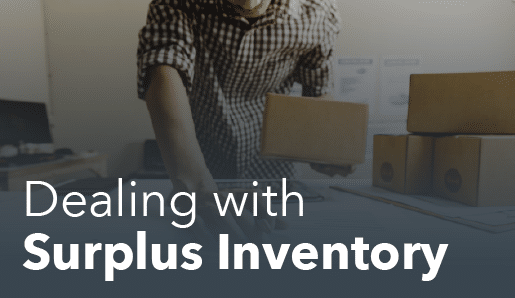Key Takeaways
- What It Is: Surplus inventory is excess stock a business holds beyond what’s needed for current demand, tying up cash and storage space.
- Why It Happens: Overordering, poor sales forecasting, or sudden drops in customer demand can lead to surplus stock piling up.
- Financial Impact: It increases storage costs, risks product obsolescence, and locks up money that could be used elsewhere in the business.
- Management Challenges: Surplus inventory complicates tracking, slows operations, and can lead to waste, especially for perishable goods.
- How to Avoid It: Use real-time inventory tracking, set min/max stock levels, and rely on accurate sales data to order smarter.
- Solutions to Clear It: Offer discounts, bundle products, donate excess, or use a POS like KORONA to optimize stock and prevent future surplus.
Surplus inventory, also known as overstocking, happens when a retailer has more products than they can sell. The biggest and most immediate problem it creates is costly storage and wasted space. Left unchecked, surplus inventory ties up money that could be used for new, profitable products, and often forces businesses into heavy discounts or write-offs to clear stock.
In this blog, we’ll show you six effective ways to get rid of surplus inventory while minimizing losses, freeing up cash, and making room for products that actually sell. By the end, you’ll understand not only why overstock happens but also practical steps to eliminate it and maximize your profits.
Let’s dive into the main causes, risks, and proven strategies for managing surplus inventory effectively.
What Does Surplus Inventory Mean?
Surplus inventory means you have more products in stock than you can sell. In other words, your shelves or warehouse are holding extra items that aren’t moving. Maybe because demand dropped, you ordered too much, or a product went out of season. That extra inventory ties up cash and space until you find a way to sell it, discount it, or get rid of it.
Causes of Surplus Inventory
The causes of surplus inventory generally boil down to a mismatch between what a business expected to sell and what it actually sold, or what it actually needed. Here are the main causes:
1. Poor Sales Forecasting
The primary cause is often a massive gap between what a company expects to sell and what they actually sell. Businesses predict a huge spike in demand for a certain item, basing that prediction on historical data, market trends, or simply a hopeful hunch.
When actual customer purchases fail to meet these inflated expectations, the substantial leftovers become surplus. It’s like a baker preparing 1,000 cookies for a small party of 50—most of those cookies will inevitably be wasted or heavily discounted. You could use our Sales Per Square Foot calculator to know how efficiently your retail space is performing.
2. Inefficient Purchasing and Production
Surplus occurs when a company orders or produces more inventory than needed in an effort to reduce the cost per unit. Companies frequently buy supplies or manufacture goods in very large batches specifically to get a volume discount (a lower price for bulk buying).
While the cost per item drops, the actual money tied up in the unsold goods (the surplus) eats into cash flow, increases storage costs, and ultimately reduces profit. Production runs may also be too long or inflexible, continuing to churn out items even after demand has noticeably begun to slow down.
3. Long Lead Times
A significant cause relates to the long delay between placing an order and receiving the goods, known as the lead time. If a shipment from an overseas supplier takes three months to arrive, the company must order inventory based on their best guess about customer demand three months in the future.
If a market taste changes, or if a competitor releases a newer, better product during that waiting period, the inventory that finally arrives may no longer be desirable. That newly arrived stock immediately becomes a challenging surplus.
4. Product Obsolescence and Seasonality
Inventory that has an expiration date, whether physical or trendy, is highly susceptible to becoming a surplus. Seasonal goods (holiday items, specific sports gear) are only valuable for a short, defined period.
If those items don’t sell out before the season ends, they are essentially dead stock until the following year.
Similarly, fashion and technology evolve rapidly; an older smartphone model or clothing line quickly becomes outdated as newer versions are launched.
Any stock remaining of the old version is instantly devalued and difficult to sell, turning into immediate surplus. Try our average inventory calculator to see how efficiently your business sells and replenishes inventory over time.

5. Errors in Inventory Management Systems
Sometimes, the issue isn’t the market or the customers, but the company’s own flawed internal data. The business’s record-keeping system might inaccurately show a low stock level for an item, prompting the purchasing team to order more.
The physical reality, however, is that plenty of that product is already sitting in a back room or another warehouse location.
The company ends up ordering duplicates because its managers don’t have a correct, real-time count of what they already possess. Hidden stock ultimately becomes an unplanned, costly surplus.
Inventory management a headache?
KORONA POS makes stock control easy. Automate tasks, generate custom reports, and learn how you can start improving your business.
Risks of Surplus Inventory
Dealing with surplus inventory is far more than a minor inconvenience; it’s a major financial drain. When a company holds onto excessive stock, it introduces several significant, costly risks that impact cash flow, profitability, and future business agility. Here are the most common and relevant risks associated with having too much inventory:
1. Cash is Trapped
The money spent to buy or make all that extra inventory is locked up in products sitting on a shelf. That capital is unavailable for more productive uses, like investing in a new, profitable product line, launching an effective marketing campaign, or upgrading equipment. The money isn’t lost, but it’s frozen and can’t help the business grow until the stock is sold—often at a discount.
2. Soaring Storage and Holding Costs
Storing mountains of unsold goods is expensive. The business pays for more than just the warehouse rent. There are utility bills (lights, heating, air conditioning for sensitive goods), insurance premiums for the higher value of stock, and the increased cost of labor to manage, track, and physically move all the items. Essentially, the business pays to keep products that aren’t generating any revenue.
3. Risk of Obsolescence (Going Out of Date)
For many items, especially technology, fashion, and anything tied to a fleeting trend, the product’s value drops rapidly the longer it sits. Once a newer model is released or a style changes, the old inventory is immediately considered obsolete or worthless. Even if the item is eventually sold, it will likely be at a heavy discount or even a loss just to clear the space.
4. Spoilage, Damage, or Shrinkage
The longer inventory sits, the higher the chance something bad will happen to it. Spoilage applies to perishable goods (food, cosmetics) that expire. Damage occurs when items get mishandled, crushed, or dusty while moving or being stored for extended periods. Shrinkage refers to loss due to theft or administrative errors. The business takes a total financial loss on any items that become unsellable.
5. Reduced Flexibility and Missed Opportunities
Excess inventory takes up physical space that could be used for items that are selling fast. By overcrowding the warehouse with old stock, the business becomes less agile. It’s harder to bring in new, in-demand products or quickly respond to a market shift. The space constraint forces the company to prioritize clearing out old stock rather than maximizing sales of current, popular items.
6. Forced Markdowns and Lower Profitability
To finally get rid of the stubborn surplus, the company is almost always forced to offer deep discounts, run clearance sales, or bundle items. If discounts become routine, customers may start to expect low prices, damaging the brand’s perceived value over the long term. While getting rid of the stock is necessary, drastically cutting the price erodes the profit margins.
| Formula Reminder: Profit Margin (%) = ((Selling Price per Unit – Cost of Goods Sold) / Selling Price per Unit) x 100 |
6 Ways to Sell or Reduce Surplus Inventory
1. Remarketing of Products
One of the most effective ways to eliminate products or items that unnecessarily occupy space is to remarket them. Sometimes, when a product is not generating enough sales, it may not be due to its quality but rather the way you market or position the merchandise in your retail store. It is relatively easy to remarket products. One thing you can do, for example, is to shift the overstocked products to a more visible location.
You can also rearrange the layout of your store’s products by placing the surplus inventory in much brighter areas, either right at the store’s entrance or changing the layout of the shelves so that they are more accessible to pedestrians. Changing the position is a great way to freshen up your merchandise, which will likely generate more demand and sales.
You can even display these products alongside trendy items and materials, featuring saleable items to generate more customer demand. This strategy aims to get the consumer to accept the product in a different way than they might not otherwise enjoy.
2. Use Clearance Sales as an Option
Leveraging clearance sales are among the best inventory liquidation strategies for overstock products. This strategy displays overstock products by offering consumers a small discount on each purchase.
You can start with 40% off these products. The offer can gradually increase to 60% – 80% to entice shoppers. Your customers will be much more willing to buy your store’s clearance products at a discounted price because your signage has already prepared them for the store’s clearance sale.
Clearance sales are a great way to eliminate excess inventory from the shelves without harming the business and generating a substantial profit that will positively impact the balance sheet. Clearance sales are not just for physical stores. You can also display them on your website and social media platforms, such as Facebook, Instagram, or TikTok.
3. Sell Your Excess Inventory to Liquidation Companies
Liquidation companies buy back products that other companies cannot sell at meager prices and then resell them under their brand. This means you will sell your unwanted products at lower prices than you bought from your original supplier. You will lose some margin, but that’s the price you pay to free up space in your store.
There are many websites where you can quickly sell off your surplus inventory. Here is an example of some websites you may want to consider if you want to use a liquidator:
- LiquidateNow
- AAA Closeout Liquidators
- B Stock Supply
- SELL Inventory.com
- Product Liquidators.com
- Kole Imports
- Merchandise U.S.A
- BoxFox
- Liquidation.com
- 360 Components
- J2 Sourcing
- Computer components
Alternatively, you may consider returning the products to your vendor or supplier while accepting a loss of margin if the vendor agrees or is legally obligated to do so.
4. Use Bundled Items And Incentives
Bundling is also considered one of the best inventory liquidation strategies. It involves grouping popular products that sell well with overstock items to entice your store’s customers to choose the bundle over regular items, or pairing special edition items with regular items for vacation promotions.
Following the same logic as bundling, you can select items or products to sell as gifts or incentives to customers after they make a purchase exceeding a certain amount. For example, offering products as incentives after purchase of more than $150 or $250 will encourage customers to buy more regular-priced items and spend a little more than usual to receive an exclusive gift.
This strategy will help you sell excess inventory faster while increasing average sales. Extra inventory can also be used as prizes in in-store and online contests. You can organize a contest in your store or on your social media accounts and choose this excess inventory as a reward to offer to your customers. It will free you from overstocking, drive buzz around your brand, and serve as a marketing campaign for other products.
5. Sell Your Overstock Products On Online Marketplaces
Another great way to reduce your surplus inventory is to sell items on eCommerce sites like Amazon, eBay, or Etsy. However, it’ll take a little longer to sell out, as you will have to create product pages, photograph each item, and market it according to the rules and expenses of each platform.
Still, these sites could be great ways to help you sell your excess inventory, as they account for the largest share of online purchases worldwide. Here’s what you need to know about each platform before you consider selling your surplus inventory there:
Amazon
Before you start selling products on Amazon, you must choose the sales plan that suits you. There are two plans: An individual plan and a professional plan. The individual plan costs $0.99 per unit sold (up to 40 units sold per month). The professional plan costs $39.99 monthly, regardless of the number of items you sell.
Also, before you sign up with Amazon, be aware that you will have to pay additional seller expenses. For each item you sell, Amazon will charge you a referral fee. Generally, most referral fees are between 8% and 15% of the sale and depend on the type of products you consider selling. In addition, if you also want to take advantage of Amazon’s FBA services, you will also be charged a fulfillment expense representing the cost of shipping your orders. Some additional selling expenses may be added if you use other optional programs to boost your sales of overstock products.
eBay
eBay is one of the largest online market platforms in the world, with over 180 million active buyers each year. To sell on its platform, eBay offers two options to vendors.
The first option is to purchase a monthly subscription for your store. For this first option, there are four plans or formulas: the Starter Plan, the Basic Plan, the Premium Plan, and the Anchor Plan. Each platform allows you to list as many ads as your chosen plan allows you to sell your excess inventory.
The second option is to become a seller without a plan. This option allows the seller to list products for sale and pay an insertion/listing fee of $0.35 per product. You pay this fee when you sell more than 200 products.
For each sale made, whether you have a sales plan or not, you have to pay an average commission of 10%. So having a selling plan can be a better and cheaper alternative for selling on eBay in the long run.
Etsy
Like Amazon and eBay, Etsy is also one of the largest marketplaces in the world, with most sellers being women in their 20s and 30s, often college graduates. If you consider selling your overstock products on Etsy, you’ll be charged a 20-cent listing fee. Etsy charges you a 3.5% expense on every sale you make.
6. Plan to Offer BOGO or Multiple Purchase Discounts
As a retail business owner, you probably know this phrase that wields the power of a thousand salespeople: “Buy One, Get One Free.” For retailers, BOGO offers are extremely effective as a surefire way to profitably liquidate poor quality or surplus inventory.
A multi-buy offer is a sales promotion strategy that encourages customers to purchase a specified quantity of a product at a reduced price. BOGOs are a great sales promotion to sell seasonal items when their season ends, such as snow shovels in the spring or lawn furniture, bathing suits in the fall, and pool toys.
BOGO offers are also very effective for grocery store owners. If a large portion of the perishable goods are not sold, this sales promotion strategy is the best to entice consumers to buy more and allow you to get rid of your excess inventory.
Here’s an example of a multi-buy promotion in action from baby clothing retailer Leo+Zo.
How to Avoid Having Surplus Inventory?
While there are some unavoidable factors that can cause overstocking in your stores, there are also some practices that contribute to excess inventory, such as placing orders blindly without knowing your store’s inventory. Avoiding overstocks and stock-outs comes down to inventory planning. You can minimize the risk of overstocking and limit its impact on your business by accurately forecasting demand using point of sale data and customer behavior information. Here are three practical tips you can follow to reduce your risk of overstocking.
1. Invest in an Automated Retail Inventory Management Software
Using spreadsheets or other manual methods for inventory management is out of the window. It is imperative to use inventory management software that can do much of the tracking, analysis, and calculations to minimize errors and order the right quantity of inventory needed from your suppliers for the smooth running of the store.
An inventory management software allows you to:
- Contact your suppliers in time so that you are never out of stock. For you, it means more sales and satisfied customers, especially during sales periods.
- Adapt production to actual needs. This way, you don’t have products stored for long periods: you gain space that you can use for more saleable or more valuable products.
- Save money by better managing the expiration dates of certain products.
According to a report, nearly half of small businesses do not have good inventory and asset management practices. About 43 percent use manual tracking methods or do not track inventory at all. Make sure you’re no longer part of this batch.
When evaluating inventory management systems, consider the key performance indicators and metrics you want to track. Make sure the inventory management software you choose aligns with your goals to provide a scalable solution for your business. While assessing options, consider the inventory management software cost to ensure it fits within your budget without compromising essential features. For example,
KORONA POS is an inventory management software perfectly designed for retail businesses and is cloud-based. This feature enables you to keep track of your inventory reports even when away from your store.
2. Track Your Sales With a POS System
Your POS system is the lifeblood of your retail store. It makes it easy for customers to pay within your store. It contains all your sales data, manages POS inventory software, and processes transactions. Make sure you have a POS system that tracks the most valuable data to help you make purchasing decisions.
The POS system you choose should allow you to quickly access information such as customer profiles, types of sales, product categories, remaining quantities, product checkout alerts, and notifications in case you’re running out of stock. Using a retail POS system like KORONA POS, capable of tracking sales and customer information, is what you need to eliminate purchasing uncertainty.
3. Leverage Retail ABC analysis
ABC analysis is an inventory management technique that determines the value of inventory items based on their importance to the business. ABC ranks products based on demand, cost, and risk data, and inventory managers categorize products accordingly. This strategy enables retail or small business owners to determine which products or services work best for their business.
- Category A items are the most profitable and have the highest sales volume. These products are the heart of your sales and replenishment and have the most impact on your inventory count cycle.
- Category B products are of medium priority. They sell, but not as regularly as Category A products.
- Category C products are the least important and have a lower demand. They are often stocked in large quantities to avoid frequent replenishment.
Product prioritization is a great way to optimize your storage space and know what to prioritize when buying wholesale from your suppliers. This strategy lets you know that category A products should be the most prioritized when ordering inventory.
Avoid Surplus Inventory With KORONA POS
A primary feature is the ability to analyze and recalculate ideal reorder levels based on your historical purchase data, current trends, and even seasonal variations. Instead of manually guessing how much to buy, the system optimizes your order quantity in seconds.
Furthermore, the platform offers tracking notifications that instantly flag slow-moving products or those with negative stock counts.
KORONA POS caters to a wide range of retail operations, particularly those with complex inventory needs or high transaction volumes. Their main verticals include niche retail shops like liquor stores, smoke and vape shops, hobby stores, and garden centers, as well as businesses that manage quick service restaurants (QSR) and ticketing operations (like amusement parks and museums). The system is built to scale. It is ideal for everything from small businesses to large multi-location franchises.
If you’re ready to ditch the spreadsheets and start leveraging smart inventory control to maximize your profits, you should definitely check it out. Ready to see it in action? Sign up for a demo with KORONA POS today by clicking below.












